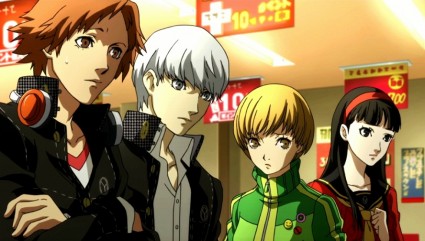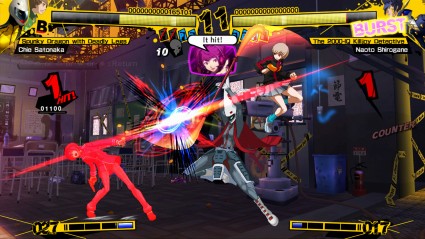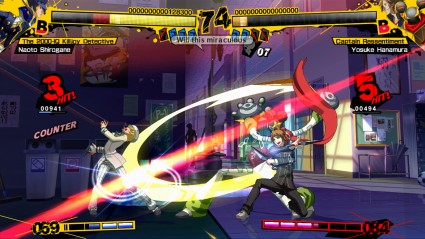Reviews
Persona 4 Arena
May 21, 2013, Author: Andy Corrigan
So, I only recently discovered that I absolutely adore Persona 4 (see here and here). I also have a particular fondness for fighting games. With that, I can only assume that someone at Persona developer Atlus has some sort of future-predicting, mind-reading doodad at their headquarters because with the aid of the very able Arc System Works, they’ve been able to mash the two things together with Persona 4 Arena.
My dream game, surely?
Me and my shadow
Set two months after the events of Persona 4, our Player Character, now dubbed Yu Narukami (Yu = You. Get it?) is heading back to Inaba to spend the school holidays with the friends he reluctantly left behind. On the train there, he’s once again summoned to the Velvet Room, met by Igor who provides him with a cryptic message about his upcoming vacation. This obviously leaves Yu wondering (see how that works?) if something has gone amiss since he left.
After arriving and settling back in at his uncle’s house and taking to his room, his curiosity gets the better of him and he tries to view the Midnight channel. Sure enough, he sees something, but not what he expects. Rather than a potential murder victim, a TV Promo plays that shows our hero and all his old friends competing in a TV World-based fighting competition, hosted by their friend Teddie.
Perplexed, Yu calls Yosuke immediately, who relieves him by explaining that he’s safe and well. After meeting up with him, Yukiko and Chie the following day at Junes, they explain that although they’re safe, Kanji, Rise and Noato are nowhere to be seen. Naturally, it’s time for the investigation team to reform and head to the TV World. Once there, they’re tricked (underhandedly, of course) into facing each other in combat.

Vive la Investigation Team!
The story mode here is presented a little differently. Rather than the traditional fighting game format, P4A’s plays out like more of a virtual novel with each fight preceded by 5-10 minutes of witty and charming dialogue. How much you’re going to enjoy this aspect will depend entirely on how much you loved the game that Arena has spun from, as it’s presented in exactly the same style and is actually written by Persona 4’s director, Katsura Hashino.
If you’re not a fan of the RPG, then it’s likely you’re going to suffer a little in this mode, in spite of the lengths it goes to show you what came before. You’d be coming into a game with established characters and relationships and without the intimacy of getting to know them as you do in Persona 4, you’ll constantly feel like you’re missing a beat. If you’re already a Persona fan, however, then you’ll be in your element. As one of those myself, I found the chat and banter continually engaging as I reacquainted myself with these fantastic characters.
For everyone else, there’s the Arcade Mode, which condenses the story into a few sentences of dialogue pre-fight and keeps its slick fighting mechanics at the forefront of the experience.
Personsa!
In pure gameplay terms, Persona 4 Arena will be considered complex to many, and you wouldn’t really expect anything less from Arc System Works. P4A, however, while more testing of your memory and your speed of thought than your Street Fighters or Mortal Kombats, is a lot more accessible than Arc System Work’s more recent work with Blazblue. Blazblue, unfortunately, remains one of those games that I enjoy a whole bunch, but still haven’t really got the hang of in the way that I would like.
P4A does lift some of its basic mechanics from Blazblue, though, such as double jumps, dashing, air-dashing and back-steps. The last item on that list is one that I always forget about; too preoccupied with getting at my opponent than giving myself space and hitting on the counter.
Aside from those few things, P4A goes mostly in its own way. The handing feels less weighted and more freeing than Blazblue and the titular Personas make for a unique take on the genre, largely because they appear and attack concurrently to their owner. With this, there are four attack buttons at play; two for your character and two for their persona.
The character’s two attacks are split simply between weak and strong and, when used in union with all the customary joystick motions, are capable of much stronger special moves. As in any fighting game, stringing these moves together to keep on top of your opponent is essential. What helps make the game accessible for newcomers, however, are the auto-combos. Continuously tap the weak attack, and if you land the first hit, your character will automatically go into a reasonably powerful, multi-hit combo. Should you have 50% SP built up in the bar at the bottom of the screen, they’ll also end the combo with the character’s super attacks.
While the auto-combo is an unusually accessible element for this genre and could be considered cheap, worry not; P4A is a game of many deep systems.
For example, if you find yourself under relentless assault and the large B next to your health bar is full, you can perform what’s known as a ‘Burst’, which will break your opponent’s current combo and send them flying, giving you chance to recover. There are four types of bursts in offensive and defensive flavours, and are extremely useful in turning the outcome of a round. Their usage is limited, though, recharging over 90 seconds; and it doesn’t recharge in-between rounds, so use sparingly. Likewise, there are a number of ways to cancel your animations in the middle of an attack, but they’ll use a fair amount of your SP meter.
Effective use of your personas in battle is the real key to victory and, like your chosen warrior, they too have a myriad of their own standard attacks and special moves. Chaining their attacks with that of your character is the most enjoyable part of the game, as you strive to forge your own set of powerful combos. Be warned that the personas aren’t invincible, though. Should they be hit four times (as indicated by the blue cards at the top of the screen), they’ll be unavailable for 10 seconds which, let me tell you, is a long time to do without their power.

Kick her ass, Chie!
To help keep fights nice and balanced, when a fighter gets below a dismal amount of health, they’ll enter an ‘Awakening’ state, which boost defences and increases their max SP, while also supercharging the rate at which it builds.
Persona 4 fans will be delighted to find that there is plenty of fan service in combat. Status ailments from the RPG can befall your characters when hit with particular attacks and can change the nature of the fight. Getting hit by an electric attack, for example, prevents you from attacking directly, leaving you only able to use your persona, who is more vulnerable without you. Ice attacks, on the other hand, have you waggling your joystick to get free of your character’s icy restraints. You could also lose steady health by being poisoned, have your directional controls reversed with confusion or enter a rage state where your defenses are less reliable.
My favourite nod to Persona 4, though, is the All-Out Attack. This is an initially innocuous looking move that, when landed, dazes your opponent long enough for you to pummel the shit out of them in a cloud of smoke, just like attacking a downed enemy in the RPG! *swoon*
Of course, no fighting game would be complete without a flashy finisher and Persona 4 Arena outdoes itself in this regard. While you’ve got the standard super moves I mentioned earlier that take over the screen true to form, they’re nothing compared to the Instant Kills. If you’re on your match-winning round, have over 100 SP on your gauge and can hit the right button combo without getting interrupted, you can end the fight instantly in a spectacular fashion, which plays out in a fun in-game cut-scene. While some are harder to land than others, they’re hugely gratifying and are pure Persona 4 goodness. My favourite so far is Chie’s, who uses her Galactic Punt to knock her foe into the middle of next week.
The Story and Arcade modes are well-bolstered by a typical Training mode and a brilliant Challenge mode, the latter of which is easily the best way to master an individual character. As seen in other games, it sees you pick a fighter and then simply work your way through a list of moves as you try to emulate their biggest combos. The implementation here is great, made all the more user-friendly by the ability to see exactly how the given combo should look just one button away.
Golden
P4A is a spectacular feast for the eyes. Every special move, every attack; hell, even every typically mundane movement is elegantly animated in its loud, hand-drawn anime style. That art style, of course, is taken right from Persona 4 and while Atlus can take most of the plaudits in terms of its original design, the game looks undeniably outstanding brought to life in this manner by Arc System Works. It’s also every bit as ‘busy’ as you’d expect from this developer, with action and motion over every inch of the screen, especially vibrant when those fists start flying.
It’s not just in the game’s fights where it looks gorgeous, though, as its presentation all round is clean, sleek and greatly effective.
Every day’s great at your Junes!
A lot of Persona 4’s infectious J-pop soundtrack has made the move over to Arena, albeit in some cases remixed. It’s every bit as iconic and as fitting as it was before, but it’s also surprisingly effective in a game of an entirely different genre. In particular, the battle music from P4, tracks like “Reach out for the Truth” as a quick example, are especially well-suited to the ebb and flow of a fighting game.
The previous voice actors retain their duties as everyone’s favourite teen gang, and the game is all the better for it. Their performances here will play a large part in ensuring that existing P4 fans fall in line with the story, while the exuberant shouts in combat never get old.

Friends forever?
A Persona-al experience.
A lot of fighting games, quite rightly, will live and die by their online modes, though thankfully Persona 4 Arena’s is as admirable as any I’ve experienced before. Amazingly, I’ve encountered absolutely no lag whatsoever when jumping online, and at least one or two laggy matches are expected in even the most stable online fighters. It does, however, have this weird slowdown as the first round gears up, but the actual match is always flawless from the exact moment that the announcer says the word ‘fight’. Quirky, but whatever; if it means a lag-free fight then I’m down for it.
When approaching the game online I highly recommend taking a patient approach; there are some highly talented players out there and with the fast, flashy pace it can prove to be a very unforgiving learning ground at times. That said, it’s rarely ever unfair and as with any decent fighting game, putting in the hard yard and taking the time to hone your skills is half the fun. Rest assured; no matter what your level, when you do start accumulating those wins, it’s satisfying in a way that few other genres can match. The online training mode, which is pretty much what the name implies (a training mode, but online with a real person), will no doubt be a blessing for many.
Fast becoming a standard in the genre, replay recordings are also a key feature and, as you’d expect, you can upload your favourite battles to the server to show off your ability. The system to view other player’s replays could use a little work, however, as at the moment it’s a bit behind the competition when it comes to quickly finding exactly what you’re after, but I’m nit-picking, really.
Victory!
Fans of the genre that aren’t particularly fans of the Persona series might well come to struggle with some of Persona 4 Arena’s themes in the offline modes, but it’s impossible to fault the game’s multi-layered fighting mechanics. Based on those alone, it’s something of a paradox; a deep, complex, hard to master fighter, but one that’s somehow accessible at the same time, ensuring that newcomers aren’t totally lost or alienated, and are encouraged to learn and improve.
There have been a lot of high-quality, recommendable releases in this genre over the last year and beyond (and I should know; I’ve reviewed most of them!), but with its quick pace, action-heavy combat mechanics, timeless characters and completely stable online mode, it’s fast become one of my favourites.
Platforms: PS3, Xbox 360 | Tagged Chie, Dojima, Fighting games, Kanji, Nanako, Noato, Persona, Persona 3, Persona 4, Persona 4 Golden, Rise, Teddie, TV World, Yu, Yukiko



